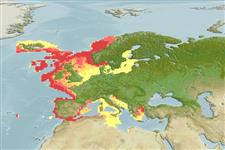Common names from other countries
Environment: milieu / climate zone / depth range / distribution range
Écologie
; profondeur 20 - 800 m (Ref. 441), usually 200 - 600 m (Ref. 88009). Temperate, preferred 16°C (Ref. 107945); 72°N - 27°N, 25°W - 27°E
Eastern Atlantic and the Mediterranean: From Finnmark, Norway south to Libya west to the Canary Is. and east to Aegean Sea. Subtropical to polar.
Length at first maturity / Taille / Poids / Âge
Maturity: Lm 3.2, range 2 - 5.5 cm Max length : 24.0 cm BL mâle / non sexé; (Ref. 441); common length : 19.0 cm BL mâle / non sexé; (Ref. 441)
Total body length: 8 to 24 cm, usually between 10 to 20 cm (Ref. 4).
Ovigerous females are found practically throughout the year, the eggs laid around July are carried for about 9 months (Ref. 4). 1 brood per year (Ref. 81133); 1.6 cm postlarval size (Ref. 81161); 1 month of pelagic period (Ref. 81160).
Holthuis, L.B. 1991. (Ref. 4)
Statut dans la liste rouge de l'IUCN (Ref. 130435: Version 2024-1)
statut CITES (Ref. 108899)
Not Evaluated
Not Evaluated
Utilisations par l'homme
Pêcheries: commercial
FAO - pêcheries: landings, species profile | FIRMS (Stock assessments) | FishSource | Sea Around Us
Outils
Sources Internet
Estimates based on models
Preferred temperature
(Ref.
115969): 3.3 - 13.7, mean 7.8 (based on 273 cells).
Résilience
Milieu, temps minimum de doublement de population : 1,4 à 4,4 années (K=0.03-0.44; tm=2).
Prior r = 0.50, 95% CL = 0.33 - 0.75, Based on 36 full stock assessments.
Vulnérabilité
Moderate vulnerability (41 of 100).
